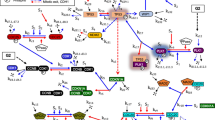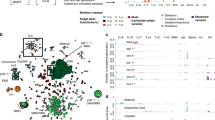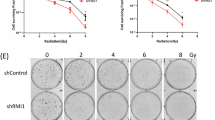Abstract
DNA damage responses (DDR) encompass DNA repair and signal transduction pathways that effect cell cycle checkpoint arrest and/or apoptosis. How DDR pathways respond to low levels of DNA damage, including low doses of ionizing radiation, is crucial for assessing environmental cancer risk. It has been assumed that damage-induced cell cycle checkpoints respond to a single double strand break (DSB) but the G2/M checkpoint, which prevents entry into mitosis, has recently been shown to have a defined threshold of 10–20 DSBs. Here, we consider the impact of a negligent G2/M checkpoint on genomic stability and cancer risk.
This is a preview of subscription content, access via your institution
Access options
Subscribe to this journal
Receive 12 print issues and online access
$209.00 per year
only $17.42 per issue
Buy this article
- Purchase on Springer Link
- Instant access to full article PDF
Prices may be subject to local taxes which are calculated during checkout





Similar content being viewed by others
References
Fearon, E. R. & Vogelstein, B. A genetic model for colorectal tumorigenesis. Cell 61, 759–767 (1990).
Stanbridge, E. J. & Nowell, P. C. Origins of human cancer revisited. Cell 63, 867–874 (1990).
Loeb, L. A. Microsatellite instability: marker of a mutator phenotype in cancer. Cancer Res. 54, 5059–5063 (1994).
Bartkova, J. et al. DNA damage response as a candidate anti-cancer barrier in early human tumorigenesis. Nature 434, 864–870 (2005).
Gorgoulis, V. G. et al. Activation of the DNA damage checkpoint and genomic instability in human precancerous lesions. Nature 434, 907–913 (2005).
Melo, J. V. & Barnes, D. J. Chronic myeloid leukaemia as a model of disease evolution in human cancer. Nature Rev. Cancer 7, 441–453 (2007).
Kops, G. J., Weaver, B. A. & Cleveland, D. W. On the road to cancer: aneuploidy and the mitotic checkpoint. Nature Rev. Cancer 5, 773–785 (2005).
Mitelman, F., Johansson, B. & Mertens, F. The impact of translocations and gene fusions on cancer causation. Nature Rev. Cancer 7, 233–245 (2007).
Nijnik, A. et al. DNA repair is limiting for haematopoietic stem cells during ageing. Nature 447, 686–690 (2007).
Gellert, M. V(D)J recombination: RAG proteins, repair factors, and regulation. Annu. Rev. Biochem. 71, 101–132 (2002).
Goodhead, D. T. Initial events in the cellular effects of ionising radiations: clustered damage in DNA. Int. J. Radiat. Biol. 65, 7–17 (1994).
Thacker, J. in Advances in Radiation Biology 16, (eds Lett, J. T. & Sinclair, W. K.) 77–124 (Academic Press, San Diego, 1992).
Collins, A. R. Mutant rodent cell lines sensitive to ultraviolet light, ionising radiation and cross-linking agents: a comprehensive survey of genetic and biochemical characteristics. Mutat. Research 293, 99–118 (1993).
Jeggo, P. A. in Molecular mechanisms in radiation mutagenesis and carcinogenesis (eds Chadwick, K. H., Cox, R., Leenhouts, H. P. & Thacker, J.) 17–22 (European Commission, Luxembourg, 1994).
Wood, R. D., Mitchell, M., Sgouros, J. & Lindahl, T. Human DNA repair genes. Science 291, 1284–1289 (2001).
Wood, R. D., Mitchell, M. & Lindahl, T. Human DNA repair genes, 2005. Mutat. Research 577, 275–283 (2005).
Kurz, E. U. & Lees-Miller, S. P. DNA damage-induced activation of ATM and ATM-dependent signaling pathways. DNA Repair (Amst.) 3, 889–900 (2004).
Abraham, R. T. PI 3-kinase related kinases: 'big' players in stress-induced signaling pathways. DNA Repair (Amst.) 3, 883–887 (2004).
Shiloh, Y. ATM and related protein kinases: safeguarding genome integrity. Nature Rev. Cancer 3, 155–168 (2003).
Hartwell, L. H. & Kastan, M. B. Cell cycle control and cancer. Science 266, 1821–1828 (1994).
Zhou, B. B. & Elledge, S. J. The DNA damage response: putting checkpoints in perspective. Nature 408, 433–439 (2000).
Canman, C. E. et al. Activation of the ATM kinase by ionizing radiation and phosphorylation of p53. Science 281, 1677–1679 (1998).
Lukas, J., Lukas, C. & Bartek, J. Mammalian cell cycle checkpoints: signalling pathways and their organization in space and time. DNA Repair (Amst.) 3, 997–1007 (2004).
Terzoudi, G. I., Manola, K. N., Pantelias, G. E. & Iliakis, G. Checkpoint abrogation in G2 compromises repair of chromosomal breaks in ataxia telangiectasia cells. Cancer Res. 65, 11292–11296 (2005).
O'Driscoll, M. & Jeggo, P. A. The role of double-strand break repair - insights from human genetics. Nature Rev. Genet. 7, 45–54 (2006).
Sax, K. Chromosome aberrations induced by X-rays. Genetics 23, 494–516 (1938).
Lea, D. E. & Coulson, C. A. The distribution of numbers of mutants in bacterial populations. J. Genetics 49, 264–285 (1949).
Cornforth, M. N. & Bedford, J. S. in Advances in Radiation Biology (eds Lett, J. T. & Sinclair, W. K.) 17, 423–496 (Academic Press, San Diego, 1993).
Toczyski, D. P., Galgoczy, D. J. & Hartwell, L. H. CDC5 and CKII control adaptation to the yeast DNA damage checkpoint. Cell 90, 1097–1106 (1997).
Harrison, J. C. & Haber, J. E. Surviving the breakup: the DNA damage checkpoint. Annu. Rev. Genet. 40, 209–235 (2006).
Bennett, C. B., Snipe, J. R. & Resnick, M. A. A persistent double-strand break destabilizes human DNA in yeast and can lead to G2 arrest and lethality. Cancer Res. 57, 1970–1980 (1997).
Garvik, B., Carson, M. & Hartwell, L. Single-stranded DNA arising at telomeres in cdc13 mutants may constitute a specific signal for the RAD9 checkpoint. Mol. Cell. Biol. 15, 6128–6138 (1995).
Deckbar, D. et al. Chromosome breakage after G2 checkpoint release. J. Cell Biol. 176, 748–755 (2007).
Riballo, E. et al. A pathway of double-strand break rejoining dependent upon ATM, Artemis, and proteins locating to gamma-H2AX foci. Mol. Cell 16, 715–724 (2004).
Syljuasen, R. G., Jensen, S., Bartek, J. & Lukas, J. Adaptation to the ionizing radiation-induced G2 checkpoint occurs in human cells and depends on checkpoint kinase 1 and Polo-like kinase 1 kinases. Cancer Res. 66, 10253–10257 (2006).
Bartek, J. & Lukas, J. DNA damage checkpoints: from initiation to recovery or adaptation. Curr. Opin. Cell Biol. 19, 238–245 (2007).
Yoo, H. Y., Kumagai, A., Shevchenko, A. & Dunphy, W. G. Adaptation of a DNA replication checkpoint response depends upon inactivation of Claspin by the Polo-like kinase. Cell 117, 575–588 (2004).
Joiner, M. C., Marples, B., Lambin, P., Short, S. C. & Turesson, I. Low-dose hypersensitivity: current status and possible mechanisms. Int. J. Radiat. Oncol. Biol. Phys. 49, 379–389 (2001).
Marples, B., Wouters, B. G., Collis, S. J., Chalmers, A. J. & Joiner, M. C. Low-dose hyper-radiosensitivity: a consequence of ineffective cell cycle arrest of radiation-damaged G2-phase cells. Radiat. Res. 161, 247–255 (2004).
Short, S. C., Woodcock, M., Marples, B. & Joiner, M. C. Effects of cell cycle phase on low-dose hyper-radiosensitivity. Int. J. Radiat. Biol. 79, 99–105 (2003).
Taylor, A. M. R. Aataxia telangiectasia genes and predisposition to leukaemia, lymphoma and breast cancer. Brit. J. Cancer 66, 5–9 (1992).
Kuhne, M. et al. A double-strand break repair defect in ATM-deficient cells contributes to radiosensitivity. Cancer Res. 64, 500–508 (2004).
Cornforth, M. N. & Bedford, J. S. On the nature of a defect in cells from individuals with ataxia-telangiectasia. Science 227, 1589–1591 (1985).
Pandita, T. K. & Hittelman, W. N. The contribution of DNA and chromosome repair deficiencies to the radiosensitivity of ataxia-telangiectasia. Radiat. Res. 131, 214–223 (1992).
Jeggo, P. A., Carr, A. M. & Lehmann, A. R. Splitting the ATM: distinct repair and checkpoint defects in ataxia-telangiectasia. Trends Genet. 14, 312–316 (1998).
Stiff, T. et al. ATR-dependent phosphorylation and activation of ATM in response to UV treatment or replication fork stalling. EMBO J. 25, 5775–5782 (2006).
Liu, Q. et al. Chk1 is an essential kinase that is regulated by Atr and required for the G(2)/M DNA damage checkpoint. Genes Dev. 14, 1448–1459 (2000).
Wykes, S. M., Piasentin, E., Joiner, M. C., Wilson, G. D. & Marples, B. Low-dose hyper-radiosensitivity is not caused by a failure to recognize DNA double-strand breaks. Radiat. Res. 165, 516–524 (2006).
Kastan, M. B. et al. A mammalian cell cycle checkpoint pathway utilizing p53 and GADD45 is defective in ataxia-telangiectasia. Cell 71, 587–597 (1992).
Varon, R. et al. Nibrin, a novel DNA double-strand break repair protein, is mutated in Nijmegen breakage syndrome. Cell 93, 467–476 (1998).
Carney, J. P. et al. The hMre11/hRad50 protein complex and Nijmegen breakage-syndrome: linkage of double-strand break repair to the cellular DNA damage response. Cell 93, 477–486 (1998).
Berkovich, E., Monnat, R. J. Jr., & Kastan, M. B. Roles of ATM and NBS1 in chromatin structure modulation and DNA double-strand break repair. Nature Cell. Biol. 9, 683–690 (2007).
Gudmundsdottir, K. & Ashworth, A. The roles of BRCA1 and BRCA2 and associated proteins in the maintenance of genomic stability. Oncogene 25, 5864–5874 (2006).
Rooney, S. et al. Artemis and p53 cooperate to suppress oncogenic N-myc amplification in progenitor B cells. Proc. Natl Acad. Sci. USA 101, 2410–2415 (2004).
Gao, Y. et al. Interplay of p53 and DNA-repair protein XRCC4 in tumorigenesis, genomic stability and development. Nature 404, 897–900 (2000).
Lim, D. S. et al. Analysis of ku80-mutant mice and cells with deficient levels of p53. Mol. Cell. Biol. 20, 3772–3780 (2000).
Linke, S. P., Clarkin, K. C. & Wahl, G. M. p53 mediates permanent arrest over multiple cell cycles in response to gamma-irradiation. Cancer Res. 57, 1171–1179 (1997).
Huang, L. C., Clarkin, K. C. & Wahl, G. M. Sensitivity and selectivity of the DNA damage sensor responsible for activating p53-dependent G1 arrest. Proc. Natl Acad. Sci USA 93, 4827–4832 (1996).
Bartek, J. & Lukas, J. Mammalian G1- and S-phase checkpoints in response to DNA damage. Curr. Opin. Cell. Biol. 13, 738–747 (2001).
d'Adda di Fagagna, F. et al. A DNA damage checkpoint response in telomere-initiated senescence. Nature 426, 194–198 (2003).
Xu, B., Kim, S. T., Lim, D. S. & Kastan, M. B. Two molecularly distinct G(2)/M checkpoints are induced by ionizing irradiation. Mol. Cell. Biol. 22, 1049–1059 (2002).
Wang, X., Khadpe, J., Hu, B., Iliakis, G. & Wang, Y. An overactivated ATR/CHK1 pathway is responsible for the prolonged G2 accumulation in irradiated AT cells. J. Biol. Chem. 278, 30869–30874 (2003).
Krempler, A., Deckbar, D., Jeggo, P. A. & Lobrich, M. An Imperfect G(2)/M Checkpoint Contributes to Chromosome Instability Following Irradiation of S and G(2) Phase Cells. Cell Cycle 6, 1682–1686 (2007).
Jazayeri, A. et al. ATM- and cell cycle-dependent regulation of ATR in response to DNA double-strand breaks. Nature Cell. Biol. 8, 37–45 (2006).
Chun, H. H. & Gatti, R. A. Ataxia-telangiectasia, an evolving phenotype. DNA Repair (Amst.) 3, 1187–1196 (2004).
Moshous, D. et al. Partial T and B lymphocyte immunodeficiency and predisposition to lymphoma in patients with hypomorphic mutations in Artemis. J. Clin. Invest. 111, 381–387 (2003).
Buck, D. et al. Severe combined immunodeficiency and microcephaly in siblings with hypomorphic mutations in DNA ligase IV. Eur. J. Immunol. 36, 224–235 (2006).
Shivji, M. K. & Venkitaraman, A. R. DNA recombination, chromosomal stability and carcinogenesis: insights into the role of BRCA2. DNA Repair (Amst.) 3, 835–843 (2004).
Risinger, M. A. & Groden, J. Crosslinks and crosstalk: human cancer syndromes and DNA repair defects. Cancer Cell 6, 539–545 (2004).
Uziel, T. et al. Requirement of the MRN complex for ATM activation by DNA damage. EMBO J. 22, 5612–5621 (2003).
Zou, L. & Elledge, S. J. Sensing DNA damage through ATRIP recognition of RPA-ssDNA complexes. Science 300, 1542–1548 (2003).
Zou, L., Liu, D. & Elledge, S. J. Replication protein A-mediated recruitment and activation of Rad17 complexes. Proc. Natl Acad. Sci. USA 100, 13827–13832 (2003).
Mailand, N. et al. Rapid destruction of human Cdc25A in response to DNA damage. Science 288, 1425–1429 (2000).
Costanzo, V. et al. Reconstitution of an ATM-dependent checkpoint that inhibits chromosomal DNA replication following DNA damage. Mol. Cell 6, 649–659 (2000).
Kuerbitz, S. J., Plunkett, B. S., Walsh, W. V. & Kastan, M. B. Wild-type p53 is a cell cycle checkpoint determinant following irradiation. Proc. Natl Acad. Sci. USA 89, 7491–7495 (1992).
Kastan, M. B. & Bartek, J. Cell-cycle checkpoints and cancer. Nature 432, 316–323 (2004).
Taylor, W. R. & Stark, G. R. Regulation of the G2/M transition by p53. Oncogene 20, 1803–1815 (2001).
El-Deiry, W. S. et al. WAF1, a potential mediator of p53 tumor suppression. Cell 75, 817–825 (1993).
Wang, X. W. et al. GADD45 induction of a G2/M cell cycle checkpoint. Proc. Natl Acad. Sci. USA 96, 3706–3711 (1999).
Hermeking, H. et al. 14-3-3 sigma is a p53-regulated inhibitor of G2/M progression. Mol. Cell 1, 3–11 (1997).
Hefferin, M. L. & Tomkinson, A. E. Mechanism of DNA double-strand break repair by non-homologous end joining. DNA Repair (Amst.) 4, 639–648 (2005).
Jeggo, P. A. & Lobrich, M. Radiation induced DNA damage responses. Rad. Prot. Dosim. 122, 124–127 (2006).
Kruger, I., Rothkamm, K. & Lobrich, M. Enhanced fidelity for rejoining radiation-induced DNA double-strand breaks in the G2 phase of Chinese hamster ovary cells. Nucleic Acids Res. 32, 2677–2684 (2004).
Wyman, C. & Kanaar, R. DNA double-strand break repair: all's well that ends well. Annu. Rev. Genet. 40, 363–383 (2006).
Rothkamm, K., Kruger, I., Thompson, L. H. & Lobrich, M. Pathways of DNA double-strand break repair during the mammalian cell cycle. Mol. Cell. Biol. 23, 5706–5715 (2003).
Saleh-Gohari, N. et al. Spontaneous homologous recombination is induced by collapsed replication forks that are caused by endogenous DNA single-strand breaks. Mol. Cell. Biol. 25, 7158–7169 (2005).
O'Driscoll, M. et al. DNA Ligase IV mutations identified in patients exhibiting development delay and immunodeficiency. Mol. Cell 8, 1175–1185 (2001).
Lobrich, M. & Jeggo, P. A. Harmonising the response to DSBs: a new string in the ATM bow. DNA Repair (Amst.) 4, 749–759 (2005).
Wang, J. et al. Artemis deficiency confers a DNA double-strand break repair defect and Artemis phosphorylation status is altered by DNA damage and cell cycle progression. DNA Repair (Amst.) 4, 556–570 (2005).
Darroudi, F. et al. Role of Artemis in DSB repair and guarding chromosomal stability following exposure to ionizing radiation at different stages of cell cycle. Mutat. Res. 615, 111–124 (2007).
West, S. C. Molecular views of recombination proteins and their control. Nature Rev. Mol. Cell. Biol. 4, 435–445 (2003).
UNSCEAR. 565–571 (United Nations, New York, 1988).
Brenner, D. J. et al. Cancer risks attribuw to low doses of ionizing radiation: assessing what we really know. Proc. Natl Acad. Sci. USA 100, 13761–13766 (2003).
Cardis, E. et al. The 15-country collaborative study of cancer risk among radiation workers in the nuclear industry: estimates of radiation-related cancer risks. Radiat. Res. 167, 396–416 (2007).
Preston, D. L., Shimizu, Y., Pierce, D. A., Suyama, A. & Mabuchi, K. Studies of mortality of atomic bomb survivors. Report 13: Solid cancer and noncancer disease mortality: 1950–1997. Radiat. Res. 160, 381–407 (2003).
Acknowledgements
We thank Professor Dudley Goodhead for critically reading the manuscript. The M.L. laboratory is supported by the Deutsche Forschungsgemeinschaft, the Bundesministerium für Bildung und Forschung via the Forschungszentrum Karlsruhe, the Deutsche Zentrum für Luft und Raumfahrt e.V., and the Wilhelm Sander-Stiftung. The P.A.J. laboratory is supported by the Medical Research Council, the Department of Health, The Association for International Cancer Research, the Leukaemia Research Fund and EU grant DNA Repair (CT-2005-512,113). Both laboratories are supported by EU grant FI6R-CT-2003-508,842 (RiscRad).
Author information
Authors and Affiliations
Corresponding authors
Related links
Rights and permissions
About this article
Cite this article
Löbrich, M., Jeggo, P. The impact of a negligent G2/M checkpoint on genomic instability and cancer induction. Nat Rev Cancer 7, 861–869 (2007). https://doi.org/10.1038/nrc2248
Issue Date:
DOI: https://doi.org/10.1038/nrc2248
This article is cited by
-
Cellular senescence in the response of HR+ breast cancer to radiotherapy and CDK4/6 inhibitors
Journal of Translational Medicine (2023)
-
Enhancement of radiation therapy by indoleamine 2,3 dioxygenase 1 inhibition through multimodal mechanisms
BMC Cancer (2023)
-
Characterizing the key genes of COVID-19 that regulate tumor immune microenvironment and prognosis in hepatocellular carcinoma
Functional & Integrative Genomics (2023)
-
The novel transcriptomic signature of angiogenesis predicts clinical outcome, tumor microenvironment and treatment response for prostate adenocarcinoma
Molecular Medicine (2022)
-
N(6)-methyladenosine methylation-regulated polo-like kinase 1 cell cycle homeostasis as a potential target of radiotherapy in pancreatic adenocarcinoma
Scientific Reports (2022)



